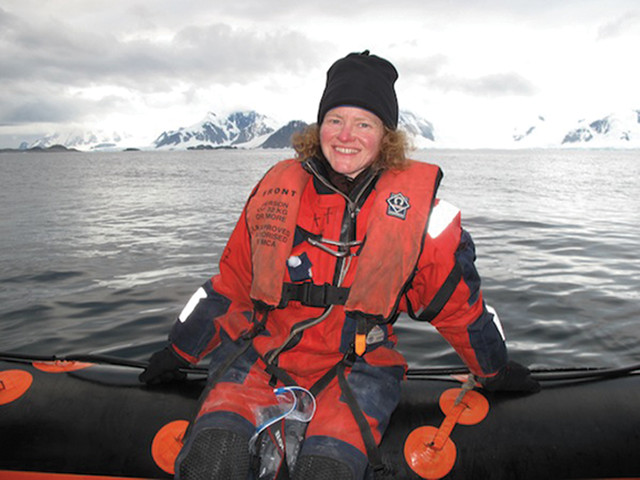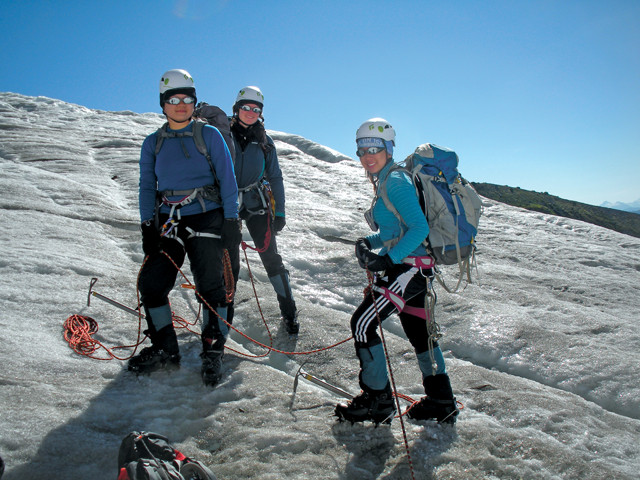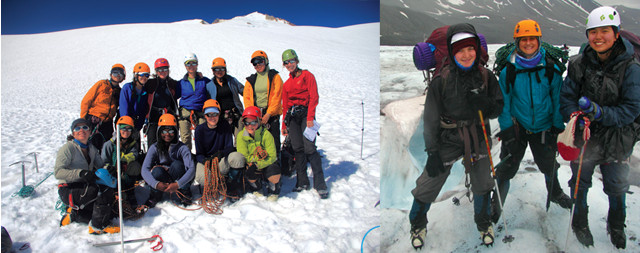
by Julia Rosen Thursday, September 17, 2015

Glaciologist Erin Pettit is an associate professor of geology and geophysics at the University of Alaska at Fairbanks. Credit: Ted Scambos.

Pettit mentors participants in the Girls on Ice program as they learn mountaineering and science skills. Credit: Girls on Ice/Erin Pettit.
If it has to do with frozen water, Erin Pettit has probably studied it. As an associate professor of geology and geophysics at the University of Alaska at Fairbanks, Pettit investigates all things ice. Her research spans vast spatial scales, from the behavior of entire glaciers down to the structure of individual ice crystals. And it has taken her from Alaska to Greenland to Antarctica, and to many of the mountain ranges in between.
But Pettit didn’t always know she wanted to study ice. After becoming a mechanical engineer, she later decided to apply her interests in fluid dynamics to the cryosphere. Among other things, glaciology afforded Pettit the opportunity to combine her scientific interests with her passion for mountaineering — a passion she now shares with young women through the Girls on Ice program, which Pettit founded in 1999.
Since its inception, more than 150 girls, ages 16 to 18, have participated in the program, which involves an intense 12-day expedition on Mount Baker in Washington’s North Cascade Range or on the Gulkana Glacier in the Alaska Range. The experience is designed to cultivate the girls’ scientific, physical and leadership abilities. In 2013, Pettit was also named an Emerging Explorer by National Geographic, an honor bestowed on about a dozen scientists, adventurers and artists every year.
Recently, Pettit spoke with EARTH contributor Julia Rosen about why we should listen to glaciers — literally — and what inspired her to get young women out onto the ice.
JR: You gave a TED-style talk for National Geographic about “listening” to glaciers. What does that mean?
EP: Listening to glaciers is really about the ice-ocean boundary. Where the glaciers meet, the water is an incredibly dangerous place to be because chunks of the glacier can collapse into the water and create huge waves. Smart boat captains will not go within a half a kilometer or so of a glacier’s terminus, and, if they do, they will spend as little time there as possible.
What that means for us as glaciologists is that it’s hard to measure and make observations of what’s going on at the ice-ocean boundary, but that’s where the action is in terms of the potential for dramatic ice retreat. Because of that, a lot of us have been trying to come up with creative ways to get at what’s happening there. Remote sensing from satellites or from airborne instruments has been around for a while, and seismic data is something that we have been using over the last decade.
About eight years ago, I was kayaking near a glacier in Alaska and — inspired by a humpback whale — I realized that listening to the sounds underwater might actually give us another perspective on what’s going on. It’s better to listen underwater because water is a better transmitter of sound. We can hear a lot more detail and we can hear things from farther away. So we started recording the acoustic signals from ice cracking, calving and other processes with underwater microphones.
JR: Why is the ice-ocean interaction so important?
EP: There are two ways to get rid of ice on a glacier. One is to change the conditions on the glacier’s surface, by either warming the atmosphere or changing the snowfall. That’s the mechanism that we’ve always focused on, and it’s a very important piece, but it’s also a more slowly changing piece. If you have one warm summer or a few warm summers, it takes a little while for that to affect the glacier as a whole.
The other way is for warm ocean water to erode the ice from below at the terminus. When that happens, it changes the buoyancy of the glacier, which might lift it off an underwater sill where it’s been resting. In the case of a tidewater glacier, that can trigger a huge retreat if the fjord gets deeper upstream of the glacier. An Alaskan glacier can easily retreat several kilometers in a year if it’s configured in the right way.
The same thing can happen in Antarctica, where you have floating ice shelves. A lot of them are perched on the edge of survivability, so if you trigger a small change with a little bit of extra ocean melting or a little bit of surface melting, then you can actually cause a huge change. For example, in 2002, the Larsen B ice shelf, which was the size of Rhode Island, disintegrated in three weeks.

Pettit doing fieldwork in Antarctica in 2014. Credit: courtesy of Erin Pettit.
JR: You have also done a lot of work on ice-sheet flow. What about it interests you?
EP: A lot of it centers on understanding ice cores. We get all of this amazing climate data from ice cores. But ice accumulation rates are one of the trickier things to reconstruct because every layer of snow that falls is compressed through time and flows toward the edges of the ice sheet. We want to understand how this happens to correct the accumulation rate, which tells us both how much it snowed in the past and the age of the ice at a given depth.
There are also issues with ice layers being folded the same way metamorphic rocks are folded. In one of the recent ice cores drilled by an international team in Greenland, researchers actually found an overturned fold and they basically had to unfold the fold to get the climate record out. Part of the reason why that happens is that different layers of snowfall will be squeezed and thinned at different rates, depending on things like the ice viscosity, which relates to small-scale crystal processes.
So I do a lot of thinking about how small-scale things — like impurities on ice grain boundaries, and the orientations of the crystals, and the size of those crystals — end up connecting to and controlling a lot of the large-scale deformation patterns.
JR: What inspired you to start Girls on Ice?
EP: When I was working as an engineer and living in Los Angeles, I volunteered for the Sierra Club’s inner-city outings program. We were working with kids from Los Angeles and Compton, and some of them had never been to the beach even though they lived 10 kilometers away. We took them on these short half-day hikes, and it was a pretty profound experience to see what happened to some of these kids in just a few hours’ time out there.
When I started graduate school at the University of Washington, I wanted to do more of that, but I didn’t find an existing program that I felt would accomplish what I wanted. So I just started brainstorming with some friends, who helped a lot along the way, and I eventually got support from UW and the North Cascades Institute.
JR: And it’s free for all participants?
EP: Yes. We did run it for a few years for a low tuition with scholarships. It turns out that, for many of these kids from disadvantaged backgrounds, having any dollar value on the tuition — even if there are scholarships available — is an extra hurdle. We started getting 10 times more applicants the year we switched to free tuition.
The other thing that we do is that we make it very clear that Girls on Ice is not a reward for past good grades or success in your academics. We want Girls on Ice to stimulate future achievement, so we don’t ask the girls for their grades and we don’t ask them to list awards they’ve won. We are not looking necessarily for the ones who have already proven that they are gifted and talented; we want to find those girls who have a passion simmering within them that’s been pushed down for whatever reason.

In 1999, Pettit founded Girls on Ice, a wilderness science education program for high school girls who spend 12 days exploring Mount Baker in the North Cascades of Washington state or an Alaskan glacier. Credit: both: Girls on Ice/Erin Pettit.
JR: What does the program entail?
EP: In the first two days, we do a little introductory day hike to get the girls mentally prepped. Then we hike up onto the mountain, where we spend eight days on the glacier. It’s not a summit-oriented program; our scientific and exploration goal on Mount Baker, for instance, is to get the girls to the active, steaming summit crater, which is about 300 meters below the true summit. Even that is hugely challenging. We really push the girls outside their comfort zone in terms of their physical ability, and we do the same in terms of their intellectual ability.
In groups of three, they design and conduct their own experiment over the course of the week. I want the girls to learn how to observe the world around them, to turn those observations into questions through their curiosity, and then to use their creativity to answer those questions. We try to walk through those steps. Each girl gets an opportunity to play a leadership role one day of the week.
Then, when we come back, for the last one and a half to two days of the project, they process all their data, put together a presentation, and give it publicly. We don’t treat these girls with kid gloves at all. We set the expectations high, but we give them a lot of support every inch of the way to meet those expectations.
JR: Why is the program just for girls?
EP: After running the program once, it became obvious that this was the best way for it to be run. One reason is that almost every mountaineering program out there is going to be 95 percent boys, especially at that age level. I think it’s hard for girls to feel comfortable and successful when they are surrounded by boys who are pulling the macho I’m-going-to-climb-this-mountain-thing. And the same thing happens with science. On average, boys will raise their hands more and speak up sooner in classrooms. All of those things mean that girls become passive learners.
So, we are giving them the opportunity to get dirty, to not shower, to be strong or weak depending on how they are feeling that day in the group, and to speak up or not. It’s very much about cultivating the whole girl, and building her confidence in both science and in her own abilities as a person and as a thinker, in whatever she goes on to do in life. I want to pass on the idea that, yeah, it can be hard, and there are going to be hurdles along the way, but you can totally do it. I mean, you just climbed this mountain!
© 2008-2021. All rights reserved. Any copying, redistribution or retransmission of any of the contents of this service without the expressed written permission of the American Geosciences Institute is expressly prohibited. Click here for all copyright requests.